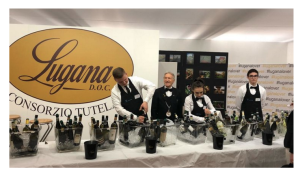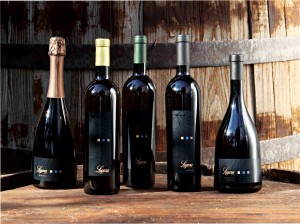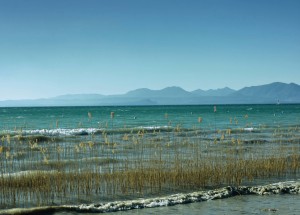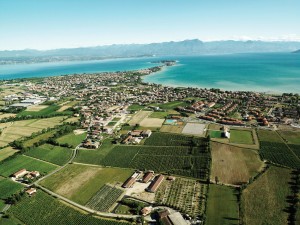
.
Today we have a preview of a session to be presented during SWE’s 43rd Annual Conference, which will take place on August 14-16, 2019 in Washington, DC. Our guest author is Susannah Gold, who tells us about an upcoming session entitled “Discover the Liquid Gold from Lugana.” Susannah Gold, CSW, CSS, DipWSET, is the founder of Vigneto Communications and East Coast Brand Ambassador for Lugana.
Lugana, the topic of one of the seminars at this year’s Society of Wine Educators conference is a white wine from Lake Garda that is making waves throughout the US and other countries in addition to having a strong showing at home in Italy. A smallish region with over 200 producers, on the Southern shore of Lake Garda, Lugana has seen incredible growth in the last years increasing by 8.6% in 2018 and now producing about 17.5 million bottles a year. This level of growth is thanks to the quality and versatility of the wines but also to the strength of the promotional activities that Lugana has undertaken in the past years. The consortium, which was formed in 1990, has set its’ sights on the US market and is frequently present both on the East and West coast.

.
The Lugana DOC is one of a handful of denominations that are part of two regions. Lugana has territory both in Lombardy and in the Veneto. All Lugana comes from the area on the Southern shore of Lake Garda and grows between 50 to 150 meters above sea level. The soils vary slightly depending on proximity to the lake but the whole area is a moraine or the remains of a glacier. Different sections have more clay and others more sand. Desenzano, Sirmione, Pozzolengo and Lonato are all main cities around the vineyards of Lugana and all fall within the province of Brescia. Peschiera del Garda is the only principal town in the region in the Veneto. However, 60% of Lugana is produced in the Veneto even though more vineysrds are located in Lombardy. This is because much Lugana is bottled and sold by Veneto based producers.
The wines are all made with the Turbiana grape, also known as Trebbiano di Lugana. After much back and forth, Turbiana is generally accepted to be a biotype of Verdicchio from Le Marche and Trebbiano di Soave, one of the grapes used to make Soave. According to the rules for making Lugana, the wine must be 90% made from the Turbiana grape. Some 10% of the wine can be made from other local white grapes, as long as they are not aromatic whites, although the tendency is to make the wines using 100% Turbiana. Lugana is made in five styles – sparkling, standard, superiore (one year of aging), riserva,(two years of aging, at least six months in the bottle) and late harvest. Most of what is seen in the United States is the standard fresh version. Much Lugana is vinified in stainless steel although some do use oak for aging for the superior and riserva versions.

.
Lugana often finishes all of the wines it has to offer by July during the harvest year. Make no mistake though, Lugana like its sister wine Verdicchio, is a white wine that can age. Many producers have started to hold back some of the wines to see how it evolves in the cellar. Thanks to its salinity and acidity as well as its residual sugar component, Lugana can pair well with a host of dishes and cuisines. This year alone has seen Lugana in Japan, Eastern Europe, the USA, Paris, London and Germany—it’s most important export market. Lugana exports up to 70% of its wines a year.
2019 has been a great year for wines from Lake Garda in general and Lugana in particular. Lago di Garda was nominated to be one of the ten top destinations by Wine Enthusiast magazine. Don’t miss an occasion to try wines from the Lugana DOC and/or to visit the region. You will surely be wonderfully surprised by its beauty and these great wines.
“Discover the Liquid Gold from Lugana” will be presented at 2:45 on Wednesday, August 14th as part of SWE’s 43rd Annual Conference, to be held in Washington, DC.

.
About the speaker: Luca Formentini, is the 4th generation in the wine sector of a family who had their 100th grape harvest in 2017. He started working in the industry at 19 and was the youngest president of a consortium in Italy. He has been the President of the Consortium of San Martino della Battaglia, the Vice President of the Consortium of Garda Classico and has been the President of the Lugana Consortium for the last seven years. He has also been the President and was a founder of the Strade dei Vini del Garda. Luca has always devoted time to associations and volunteering with groups that aim to product the environment, the landscape and the area of Garda. He is also an active musician and composer of contemporary music. Luca is the proud father of an 11-year-old girl.



